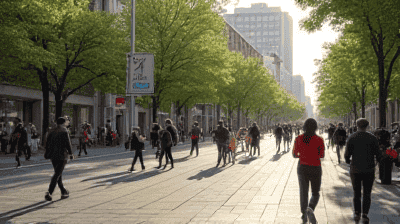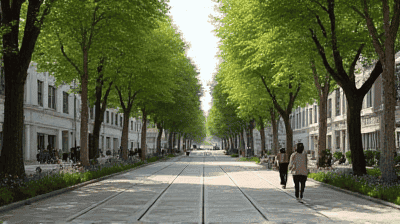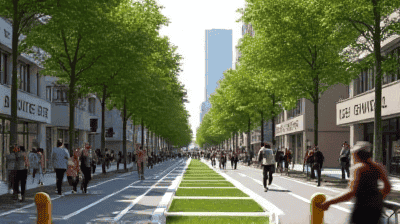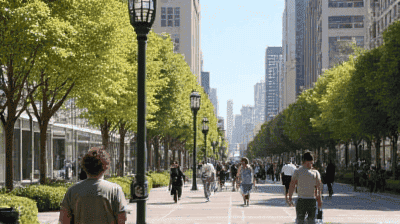
In our rapidly urbanizing world, cities face increasing challenges related to pollution, congestion, and overall quality of life. As more people gravitate towards urban centers, the reliance on automobiles has reached unsustainable levels, leading to negative impacts on the environment and public health. In response to these challenges, many cities worldwide are adopting innovative solutions such as car-free zones.
Car-free zones refer to designated areas within a city where vehicles are restricted or prohibited from entering. These zones can vary in size, from single streets to larger districts, and are often implemented in city centers, pedestrian malls, and historic districts. The main goal of car-free zones is to reduce traffic congestion, lower pollution levels, and create more pleasant urban environments for pedestrians and cyclists.
Car-free initiatives are not entirely new; many cities have implemented variations of this concept throughout history, especially in response to the dangers and inconveniences caused by excessive car traffic. In the mid-20th century, some European cities began experimenting with pedestrian-only areas, especially in the wake of urbanization and the rise of automobile culture. Over the years, the concept has evolved and gained traction, especially in light of contemporary concerns about climate change and urban livability.

Car-free zones offer a multitude of benefits that contribute to the transformation of cities into pedestrian paradises. These benefits can be categorized into several key areas:
One of the most significant benefits of car-free zones is the reduction in air pollution. Vehicles are a major source of greenhouse gases and other harmful emissions that contribute to smog and respiratory illnesses. By limiting the number of cars in urban areas, cities can improve air quality, making environments healthier for residents.
Car-free zones can play a critical role in combating climate change. Transportation is a leading contributor to carbon emissions, and encouraging walking, cycling, and the use of public transport reduces the overall carbon footprint of urban areas. By adopting policies that promote car-free environments, cities can contribute to global efforts to mitigate climate change.
Eliminating cars from certain areas opens the door for urban planners to introduce more green spaces, parks, and recreational areas. Increased vegetation helps absorb carbon dioxide, provides shade, and enhances biodiversity, contributing to overall urban resilience.
Car-free zones can significantly boost local economies by attracting visitors who are more likely to explore pedestrian-friendly spaces. Retail businesses often flourish in these environments as people are more inclined to shop and dine when they can easily navigate the area on foot. This economic revitalization can lead to job creation and increase tax revenues for local governments.
Maintaining infrastructure for car travel can be costly for cities. By reducing the need for extensive road maintenance and parking facilities in favor of pedestrian pathways and public transit, municipalities can save money. These savings can be redirected into other essential services such as education, healthcare, and public safety.
A shift towards pedestrian-centric urban design directly benefits public health. Increased opportunities for walking and cycling promote physical activity, reducing the risk of lifestyle-related diseases such as obesity, diabetes, and heart conditions. Additionally, better air quality and reduced noise pollution contribute to overall well-being.
Car-free zones foster environments where people feel more comfortable engaging with one another. By removing the barriers that cars create, such as traffic and parking, public spaces become more welcoming for socializing, cultural events, and community gatherings. This improved social interaction fosters a sense of community and belonging.
Car-free zones often lead to a more visually appealing urban landscape. Streets transformed into pedestrian areas can incorporate public art, landscaping, and attractive architecture, all of which enhance the overall aesthetic. This investment in urban beauty can significantly enrich residents' experiences.
Many residents report an enhanced quality of life in car-free zones. By providing safe, pleasant, and accessible spaces for interaction and movement, these areas contribute to happier, healthier communities. Residents are likely to feel more connected to their city and one another, leading to stronger social bonds.
Creating successful car-free zones requires careful planning and consideration. Urban planners and city officials must analyze various factors to ensure that these transformations are effective and beneficial for all residents.
Engaging local stakeholders, including residents, businesses, and community organizations, is essential when designing car-free zones. Community participation can provide valuable insights into the needs and preferences of those who will use the space while building support for the initiatives.
For car-free zones to be successful, there must be accessible alternatives to driving. This includes enhancing public transportation services, creating safe cycling infrastructure, and ensuring that pedestrian pathways are well-maintained and well-connected to other parts of the city.
Ensuring pedestrian safety is paramount in car-free zones. Urban planners should implement measures such as better street lighting, clear signage, and designated crosswalks to protect pedestrians and cyclists from potential hazards.
Effective communication regarding the rules and benefits of car-free zones is vital for encouraging compliance and fostering positive public perception. Clear signage can inform drivers about entry restrictions and alternative transportation options, while providing pedestrians with navigation assistance.

Several cities around the world have successfully implemented car-free zones and transformed urban landscapes into pedestrian-friendly environments. Here are a few noteworthy examples:
Barcelona has embraced the concept of superblocks, which restrict vehicular traffic in designated neighborhoods and prioritize pedestrians. By closing off certain streets to cars, Barcelona has created vibrant public spaces characterized by parks, plazas, and recreational areas. The initiative has resulted in improved air quality, reduced noise pollution, and increased community interaction, making the city a global model for urban transformation.
Oslo is making headlines as one of the first major cities to implement a comprehensive car ban in its city center. In recent years, the city has prioritized the development of bike lanes, public transportation options, and pedestrian pathways. These changes have resulted in a significant reduction in car traffic, improved air quality, and increased foot traffic in local businesses. The car ban has transformed Oslo into a more livable city and has inspired similar initiatives in other urban areas.
Amsterdam is famous for its cycling culture and pedestrian-friendly design. The city has long prioritized bike infrastructure, but in recent years, it has taken steps toward expanding car-free areas. By closing certain streets to cars and enhancing public spaces along canals, Amsterdam has created a more inviting atmosphere for both residents and tourists. The ongoing transformation emphasizes sustainable urban planning and the significant role of alternative transportation.
Paris has made significant progress in expanding its car-free zones under Mayor Anne Hidalgo's leadership. The city implemented temporary car bans in response to air pollution crises and has since made many of these bans permanent. The creation of pedestrian-only zones around iconic landmarks such as the Seine River and parts of Montmartre has revitalized these areas, making them more accessible and enjoyable for pedestrians. The initiative has improved air quality and has also provided opportunities for public events, art installations, and local markets.
New York City has embraced car-free initiatives in various areas, including Times Square, which underwent a transformation from a congested thoroughfare into a pedestrian-friendly plaza. By reducing vehicular traffic in the heart of the city, officials have created vibrant public spaces that host events, recreational activities, and gatherings. This car-free approach has encouraged local economic growth while enhancing the urban experience for residents and tourists.
While the benefits of car-free zones are clear, the transition can be met with challenges. Addressing these obstacles is essential for the successful implementation of pedestrian-friendly policies.
Resistance from residents and businesses who rely on car access may hinder the establishment of car-free zones. Public education campaigns can help overcome this resistance by highlighting the long-term benefits of car-free initiatives, including improved environment, public health, and urban aesthetics.
Ensuring access for residents, businesses, and emergency services is critical when designing car-free zones. Finding this balance often requires detailed planning and collaboration among stakeholders.
Car-free zones require ongoing maintenance and effective management to ensure that public spaces remain clean, safe, and appealing. Cities may need to allocate resources for regular upkeep and address any issues that arise post-implementation.
Businesses may initially worry that restricting car access will deter customers. Providing incentives and support for local businesses can mitigate this concern and encourage businesses to adapt to the new environment.

The future of urban design and transportation increasingly leans toward reducing car dependency and embracing pedestrian-friendly environments. Car-free zones are likely to play a pivotal role in this transformation.
As cities evolve, integrating car-free zones within broader urban planning efforts will be essential. City planners should consider the interconnectedness of neighborhoods, transportation systems, and community needs to create effective car-free areas.
Technological advancements will play a significant role in supporting car-free initiatives. Smart city technologies can optimize public transportation systems, enhance pedestrian navigation through mobile applications, and monitor environmental quality in real-time.
Supporting policies from governments at all levels will be essential for promoting car-free zones. Policymakers should prioritize investments in sustainable transportation infrastructure, public transit, and green spaces while providing incentives for businesses to thrive in these environments.
Car-free zones are rapidly transforming cities into pedestrian paradises, providing numerous environmental, economic, social, and aesthetic benefits. By prioritizing walking, cycling, and public transportation, cities can reduce pollution, enhance public health, and create vibrant communities. Successful case studies from around the globe demonstrate that implementing car-free zones can lead to significant improvements in urban livability.
As urban planners and policymakers strive to confront the challenges posed by urbanization and climate change, car-free zones represent a viable and attractive solution. By embracing the principles of pedestrian-centric design, cities can pave the way for a brighter, cleaner, and more connected future.